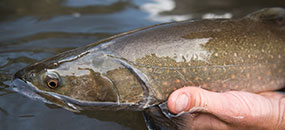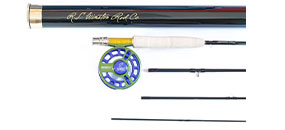Location: Southcentral Montana
Type of stream: Tailwater
Angling methods: Fly, Spin
Species: Rainbows, Browns
Access: Moderate
Season: Year-round
Supporting Services: Fort Smith, Hardin
Short take: One long riffle of ‘bows and browns
Handicapped Access: None
Closest TU Chapter: Magic City Fly Fishers
Think of the Bighorn below the Yellowtail Dam afterbay at Fort Smith as a 32-mile long tailwater riffle. Dropping only about 10 feet per mile, the river is bounded on the west by bluff lands, broken here and there by valleys from which warm creeks charge the river. Scores of small islands break up the river’s flows. Myriad side channels carve narrow runs that fish more like small streams than a big river. Most anglers float the river, stopping frequently to wade and fish.
The river runs clear and cold and is open to fishing year ‘round. Midges open each new angling season in late winter. Then come blue-winged olives arriving in early April. Tan caddis of #10 to #16 size take over in late May or early June and provide a main course for trout through July. They are followed by black caddis which are smaller - #16 to #20 - than their lighter colored cousins. June and July also see hatches of pale morning duns and yellow sallies, the river’s sole stonefly. High summer brings forth swarms of flying ants, another stable of Bighorn trout. As terrestrials are peaking, so too are pseudocleons, represented by a tiny blue-winged olive in #20 to #24 with a light body almost like that of a pale morning dun. Fish the nymph form as well. The trico hatch in September is exceptional.
Phenomenal as the summer fly fishing can be, I’m still wed to the notion that fall’s the best time to head West. How come? Crop lands east of the Bighorn are rich with pheasants. Add huns, chukars, and grouse and a healthy dose of ducks and geese, especially after irrigation ditches get a little icy. Bring your lab. Float from Bighorn access down to Mallard Landing (where else?). Start early and set your decoys before dawn on any backwater. When you’re done with ducks, head for the next island and push it for pheasants. Now the day’s main event begins. Nymph rapids and the banks for rainbows and browns. A more perfect day in early November I simply cannot imagine.




